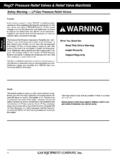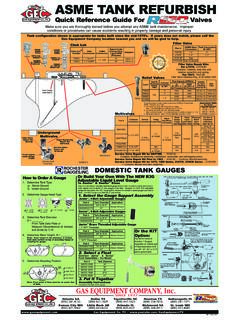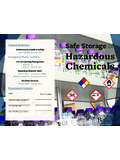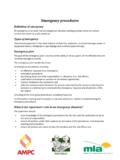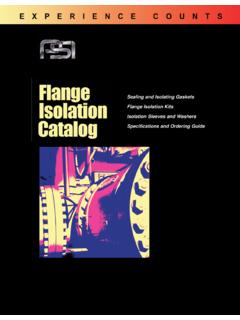Transcription of BULLETIN 500-001 LIQUEFIED GAS …
1 BULLETIN 500-001 . Section 500. Effective November 2001. Replaces October 1969. LIQUEFIED GAS HANDBOOK. Practical suggestions on the design and installation of handling systems for propane, butane, anhydrous ammonia and similar LIQUEFIED gases BULLETIN 500. Before installing propane equipment This handbook is about Blackmer lique- on any mobile vehicle or in a perma- fied gas pumps and compressors, their nent location, review the requirements installation and operation. It out- of Pamphlet No. 58 "Standard lines several practical suggest- for the Storage and Handling of tions and guidelines that can LIQUEFIED Petroleum Gases.". be used in the design of new trucks and plants as You can obtain a copy from: well as the troubleshoot- National Fire Protection Association ing of older installations. 1 Batterymarch Park It is not, nor is it intended Quincy, MA 02269-9101. to be, a treatise on the Telephone: 1-800-344-3555. entire LPG industry. There web: are many excellent publica- tions that cover in detail the This pamphlet is generally accepted by various other specialized regulatory authorities and is the indus- phases of this business.
2 Try guide to safety in equipment and handling procedures. In addition, check state laws and ordinances on the subject. Equipment on vehicles used in interstate service must comply with applicable requirements of the Department of Transportation. Information for all Blackmer products, both present and past models, is available at our website. Specification Sheets, Parts Lists, Instruction Manuals and more are all available worldwide 24 hours a day. Table of Contents About Blackmer 2. General Characteristics of LIQUEFIED Gas 3. Positive Displacement Pumps 4. Compressors 6. Propane Installations 12. Delivery Systems on Bobtail Trucks 15. Delivery Systems on Transports 24. Stationary Motor-Driven Pumps 27. Vaporizer/Standby Plant Applications 29. Appendix 31. 1. About Blackmer In 1903 Robert Blackmer, inventor of Blackmer has two research and design the first Rotary Vane pump, success- locations: Grand Rapids, MI USA and fully launched a new technology (slid- Auxerre, France.)
3 These locations work ing vane pumps) effectively setting around the clock testing not only new valuable pumping standards for years products, but also changes and to come for pump companies around advancements made to existing prod- the world. For nearly a century, ucts. Experts in the field are continu- Blackmer has continued to strengthen ously providing one-on-one product its commitment of providing quality Mission Statement training throughout the world. products to its valued customers. Blackmer believes strongly in its team, To provide advanced flow solutions for whose purpose is to service its cus- Meeting customer's challenges tomer's needs through years of experi- through a combination of expertise, applications in the chemical, refined fuels, ence and longevity in the workforce. dedication and support, allows food/sanitary, oilfield, wastewater, pulp Blackmer to provide the most effective products with the information cus- Blackmer has become a global compa- and paper, transport and military tomer's need to choose the right ny, supplying markets around the product for their applications.
4 It is the /marine industries. Through product tech- world with expert flow-technology people at Blackmer that make the applications. Blackmer is quick to nology, total life cycle cost value, an inter- respond to the industry's rapid company what it is today. With a diverse range of market segments and national manufacturing presence and glob- advances, through constantly reengi- experts in the field, Blackmer takes neering its products to include new al, distribution channels, we strive to deliv- innovations. great pride in its services and products available worldwide. er our products and services with the However, Blackmer is about more than quality, expertise and efficiency our cus- the latest, cutting-edge technology. Blackmer has five manufacturing facili- ties located around the world: Grand tomers deserve. The employees at Blackmer work Rapids, Michigan, Claremore, together as a team in order to meet Oklahoma, Oklahoma City, Oklahoma, customers' ever-evolving needs with Ward Hill, Massachusetts and Auxerre, keen knowledge and insight.
5 Blackmer France. Each facility is fully equipped provides outstanding service that with the latest technology and trained enhances its customer's business from technicians needed to provide prod- site training to expert engineering sup- ucts to meet the industries highest port. The customer is always the first global standards with local responsive- priority at Blackmer. ness. PRODUCTS. LG and LGL Sliding Vane Pumps These ductile iron pumps, available in 1 to 4" sizes are all UL listed for LPG and Anhydrous Ammonia Service. Models are available for motor fueling, cylinder filling, vaporizers, general transfer and truck loading/offloading. BV Bypass Valves All positive displacement pumps are to be fitted with a back-to-tank bypass valve. To serve that purpose Blackmer bypass valves are all ductile iron and available in to 2" sizes. Hydrive Hydraulic Coolers Hydraulic drive systems for truck mounted pumps are becoming more and more popular. The Blackmer Hydrive Hydraulic Coolers allow these systems to operate more efficiently.
6 LB Compressors for LPG and NH3 Transfer These ductile iron compressors are available in four sizes to meet any application. Compressors are especially well suited for unloading rail cars, evacuating cylinders and tanks and anywhere vapor recovery is required. In addition to products available for the transfer of LIQUEFIED gases, Blackmer manufactures a wide range of products for use in many industries and markets worldwide: -Sliding Vane Pumps -System One Centrifugal Pumps -DMX Air Elimination Systems -Abaque Peristaltic Hose Pumps -HD Industrial Process Compressors -HR Gear Reducers -Tarby Progressing Cavity Pumps -Enterprise Rotary Vane Compressors -Hand Pumps -Eccentric Disc Pumps -Typhoon &Mistral Screw Compressors -Labyrinth Seals for Pumps 2. General Characteristics of LIQUEFIED Gas LPG is an abbreviation for " LIQUEFIED When LIQUEFIED , LP gases are always at The single significant difference petroleum gas" and encompasses sev- their boiling point at normal tempera- between propane and butane is their eral products in the hydrocarbon fami- tures.
7 The slightest drop in pressure boiling points, the temperature at ly; compounds composed of carbon or the least addition of heat will cause which each will vaporize. Butane boils and hydrogen of varying molecular them to boil and give off vapor or gas. at approximately +32 F (0 C), propane structures. Propane and butane are This characteristic becomes critical at -44 F (-42 C) at atmospheric pres- the two best known hydrocarbons that when considering the transfer of lique- sure. Therefore, at 0 F (-18 C), butane are used as fuel in homes, businesses fied gases from one tank to another. will not vaporize at atmospheric pres- and industries. In the international Being a LIQUEFIED gas, LPG must be sure while propane will. Consequently, markets, LPG predominantly refers to a stored in an enclosed container under at any given temperature, the pressure propane-butane mixture. These mixes pressure. The fluid in a tank is in state for a propane vessel will be higher may vary in composition from ones of equilibrium with the gas vapors on than a butane vessel.
8 Refer to chart in that are predominantly butane to ones top of the liquid providing the tank the Appendix B titled, "Vapor Pressure which propane is the principal con- pressure to keep the liquid from boil- of LIQUEFIED Gases.". stituent. ing. LPG is inherently a safe fuel. Two LPG, whether butane or propane, is Appendix A shows a chart outlining prime factors contribute to LPG safety;. unique in that it can be transported the physical properties of propane and one is its narrow limits of flammability, and stored as a liquid but when butane. The specific gravities of the the other is the fact that the container released it will vaporize and burn as a liquids are just over half that of water. in which it is stored is extremely gas. Also, LPG can easily be changed This means a gallon of propane or strong and airtight. If the confined gas from either liquid state or gas state. butane weighs only half the weight of cannot escape it can't burn. LPG has No other commercial fuel has these a gallon of water.
9 Also, propane and narrower limits of flammability than characteristics. Natural gas, for exam- butane have viscosity of about most fuels. For propane, the respec- ple, cannot be transported in a tank in centipoise, which make them approxi- tive limits are and This any meaningful quantities unless it is mately 10 times thinner than water. means that when the concentration of either compressed to extremely high This property makes LPG a difficult LPG in air is less than about or pressures or chilled to -259 F fluid to pump since a low viscosity more than , the mixture will not (-126 C), at which point it liquefies. fluid is harder to seal and prevent support combustion. Even when compressed, it contains pump slippage. only a fraction of the useful energy of the identical volume of liquid-state LPG. PROPERTIES OF LPG. The following properties of LPG should be understood for the purpose of promoting safety in usage and for intelligent action in handling this fuel: 1. The gas or vapor is heavier than air.
10 2. The gas or vapor will diffuse into the atmosphere very slowly unless the wind velocity is high. 3. Open flames will ignite air-gas mixtures which are within the flammable limits. 4. Gas-air mixtures may be brought below the flammable limit by mixing with large volumes of nitrogen, carbon dioxide, steam or air. 5. Fine water sprays reduce the possibility of igniting gas-air mixtures. 6. The vapor pressure of this fuel is greater than gasoline. It is safely stored only in closed pressure vessels designed, con- structed and maintained according to appropriate regulations and equipped with safety devices as required. 7. Liquid in open vessels will evaporate to form combustible mixtures with air even if the ambient temperature is many degrees below the boiling point. 8. The rapid removal of vapor from the tank will lower the liquid temperature and reduce the tank pressure. 9. The liquids will expand in the storage tank when atmospheric temperature rises. Storage tanks must never be filled completely with liquid.
